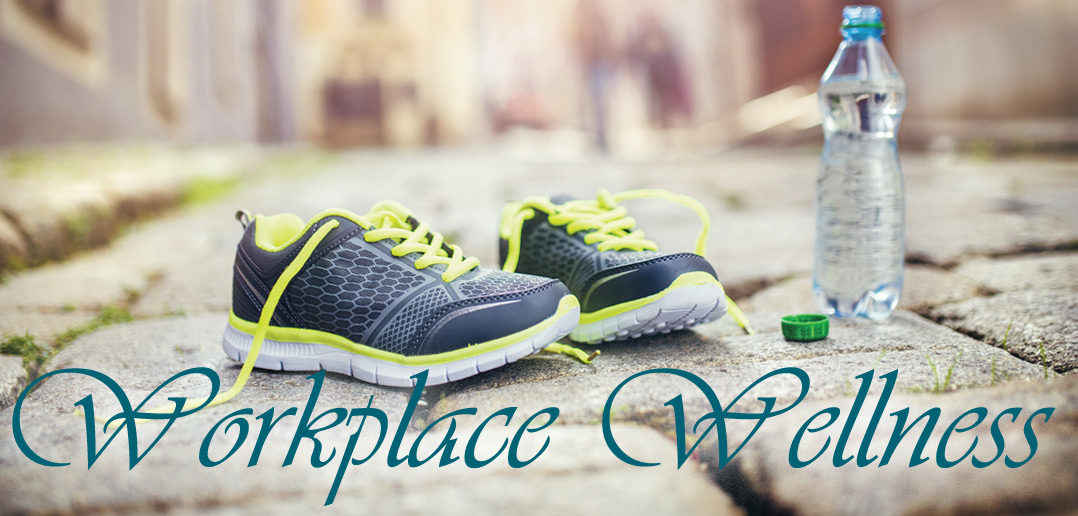When it comes to running a business, there’s no doubt that the health and safety of your workforce will directly affect your bottom line. Therefore it’s ultimately wise to take the wellbeing of your employees into consideration, ensuring that the workplace is safe and promotes a healthy lifestyle for employees. Safety and wellness arguable covers a lot of territory, so its applications in each different business or organization will vary. Most often this will fall into the human resources department, depending on how your company is structured. But no matter the size or scope of your operations, if you have a program in place that fits your needs and goals, the benefits of healthy and happy employees who are completely comfortable in the work environment and encouraged to be better people every day will speak for themselves—loud and clear.
According to the Center for Disease Control and Prevention (www.cdc.gov), “A workplace health program is a health promotion activity or organization-wide policy designed to support healthy behaviors and improve health outcomes while at work. These programs consist of activities such as health education and coaching, weight management programs, medical screenings, on-site fitness programs, and more.
Workplace health programs also include policies intended to facilitate employee health, including allowing time for exercise, providing on-site kitchens and eating areas, offering healthful food options in vending machines, holding ‘walk and talk’ meetings, and offering financial and other incentives for participation. Effective workplace programs, policies, and environments that are health-focused and worker-centered have the potential to significantly benefit employers, employees, their families, and communities.”

Katie-Hammer
The Waterford
Communities
Katie Hammer of The Waterford Communities (thewaterford.net) offers further insight on workplace wellness from the perspective of the employee:
“According to The University of Miami, ‘Wellness is the dynamic process of becoming aware of, taking responsibility for, and making choices that directly contribute to one’s wellbeing and that of the common good. It is the integration of body, mind and spirit and the ongoing development of one’s own meaning in life.’ There are 8 different dimensions of wellness, and occupational wellness is one that we at The Waterford Communities strive to have all of our staff obtain. To be in the healthiest state of occupational wellness, you are doing exactly what you want to do in life, and you are comfortable with your personal and financial situations.
The Waterford Communities have a few recommendations for our staff and for everyone to make obtaining occupational wellness easier:
• Set Goals! Now this doesn’t mean set huge goals that will take some time to accomplish, but mini-goals to get you through your day with a little bit of added fun. You can turn these mini-goals into little games or contests you play, such as “I’m going to get this whole stack of paperwork sorted and filed in an hour.” When you achieve this, it’s like winning a contest! You will still have to focus on what you are doing but it just adds a little fun and motivation to your work.
• Take Breaks! At The Waterford Communities we know it can be a struggle to take a break from what you are doing because you may have deadlines to meet, there is so much to be done, or you just feel like there isn’t a right time to take a break. Taking breaks will actually improve your job performance and it can reduce your overall job stress. Even if it is just a 5 minute break here and there to get up and walk around the room, take that break!!
• Make Lists! Making lists is a simple time management technique that helps reduce stress and improves your ability to get your work done in a timely manner. The most basic list is the To-Do List. The Waterford Communities recommend when making this list make sure that you keep it somewhat short so you allow yourself to get the things done for the day without overwhelming yourself. The best feeling is crossing an item off that list and knowing you are one step closer to finishing!
• Clean Workspace! When your workspace is clean and organized it makes it much easier to keep track of everything that you have going on and it will help minimize anxiety. When you are cluttered with piles of paperwork it’s easy to become overwhelmed and stressed.
The Waterford Communities realize that our jobs take up so much of our time that it’s important for our overall wellbeing that we are doing what we love. People who are doing what they love and what they are meant to do are able to get a deeper sense of their meaning and purpose. When evaluating your occupational wellness ask yourself these 3 questions, and if you answer ‘No’ to any of them, it may mean you need to improve on that area of your occupational wellness.
• Do I enjoy going to work most days? • Do I have a manageable workload? • Do I feel like I can talk to my boss and co-workers if a problem arises?

Tonya Vyhlidal
Nebraska Safety Council / WorkWell
In conclusion, I think the quote from Jessica Rhodes is most fitting: ‘As you search for your unique role in the working world, remember that it’s the people who do what they love that truly make the difference.’”
Tonya Vyhlidal, M. Ed., CHPD, Director of WorkWell, a division of the Nebraska Safety Council (www.nesafetycouncil.org), also offers a couple helpful tips for the individual:
1. Get enough sleep (7-8 hours is recommended for adults). Not getting enough sleep or even improving sleep quality has major effects on decision making, attention to detail, mood, and overall health. Sleep is not something we should subtract from – you can never “catch up” on sleep once you’re deprived. Make it a habit to build a sleep ritual and make sleep and recovery a priority.
2. Get moving and integrate movement into your work day. Sedentary work behavior is a culprit for poor health – get up and move around at least once each hour. Take a short walk, fill your water bottle, do some light stretching, walk down the stairs and back up – something that allows your body to move. Your body is designed for movement and the less movement you have the more risks you actually incur. This might include poor sleep, weight gain, attention issues, fatigue, chronic illness, etc.
“With so many jobs requiring people to remain seated at a desk, it’s easy to pick up bad habits that will affect your body negatively, both short term and long term,” adds Dennis Varley, owner of The Body Shoppe (www.thebodyshoppelincoln.com) . “People need to be sure that their chairs and desks are at the proper height, and to be aware of their posture, keeping shoulders down and back as well as sitting up straight with knees bent at 90 degrees. Computer desks that raise up so that people can stand and work have become very popular lately, and with good reason, as it’s a cost effective way to provide a healthier option for your employees as an alternative to being seated for a majority of the day. There are also some simple breathing techniques people can also do to help with daily job stress and keeping the body aligned right, which we are happy to teach upon request. The Body Shoppe does offer a chair massage service that’s ideal to incorporate in the workplace, as it has been proven to help with workplace wellness and boosts productivity. We can provide these on-site or the client can come see us at our location at 3601 Calvert St. Suite 20.”

Dennis Varley
The Body Shoppe
Specifically addressing employers and their role in workplace wellness, Tonya Vyhlidal further advises, “Each company should follow the evidenced-based model of development for workplace wellness and safety. This all starts with an assessment of leadership support–making health, safety, and wellbeing a priority and part of the strategic part of the business, leading by example, providing the support and resources for wellness and safety programming, and so on. Secondly, you’ll want to take a snapshot of your current wellness and safety statistics (incident rates, biometric data, health risk assessment, health insurance costs, workers comp costs, etc.) to determine where you are at and what your major opportunities are. Then, move into action through the development of an operating plan (annual) and a strategic plan (3-5 year). The plan should attend to risk areas identified and also compliment and integrate into the company culture, strategic direction, and organizational practices. Making sure you prepare a plan that is in line with the organizational direction will be key. You want wellness and safety to foster the development of your organization and to help people – if the programs are not designed to do this and are just purely placed to ‘reduce costs’, or poorly planned or communicated, you will have very little success.
The Nebraska Safety Council and WorkWell provide a wide variety of program options, education options, and networking opportunities for employers statewide. It’s hard to pick just one or two to highlight as we believe in meeting the organization where they are at and providing solutions that will enhance their ability to meet their goals. Some very popular ones currently are CPR /First Aid training, safety trainings (based off of industry need), workplace wellness 101 training (JumpStart), and on-site one-on-one health coaching. “
She continues, “Current trends in wellness and safety are kind of all over the place, but it’s important for people to understand that just because something is the trend doesn’t mean that it’s the ‘right choice.’ I’ve seen so many organizations change programming options just because it’s the trend rather than investigating the need and taking the baby steps necessary to acquire the desired change. So as I provide some ideas I think it’s important to recommend that organizations ask some questions:
• What do we want to be different?
• What’s not working that requires change?
• Have we really done a thorough evaluation to determine where the gaps are?
With that some ideas include: 1) Integrating your workplace resources to provide a more Total Worker Health or an overall employee wellbeing model (selection practices, training programs, communication, wellness, safety, etc.); 2) Using more 1-1 coaching or instruction to support behavior change; and 3) Providing on-site health screenings with an attachment to workplace health benefit options (such as receiving a premium discount for achieving the health screening criteria, etc.).
Finally, we encourage wellness and safety professionals and divisions within organizations to bring these two groups together and collaborate. Often times safety and wellness don’t land under the same department in an organization, but you’ll benefit from a regular meeting of the minds and being on the same page.”

Bryan Heinz
Husker Rehabilitation & Wellness Center P.C.
Bryan Heinz, Director of Wellness at Husker Rehabilitation & Wellness Center, P.C. (www.huskerrehab.com) , also emphasizes the importance of movement and sleep while touching on the importance of nutrition as well. “There are three health-related issues that I feel could improve an individual’s performance at any workplace: Exercise Regularly, Sleep, and Healthy Eating.
Exercising regularly will help promote many of good things both inside and outside the body. Other than looking better, feeling better about your appearance usually promotes confidence and confident employees are productive employees. It also increases energy levels which keeps an employee alert and reduces mistakes. And finally, it boosts your metabolism and promotes deeper sleep.
Which brings me to my next point: Sleep. There is a lot to be said about sleep but I only want to touch on getting ample amounts of sleep vs. getting enough sleep. Getting ‘just enough’ sleep leaves you with the mid-afternoon sleepy feeling which in turn could make you feel irritable, forgetful, and rushed to leave the office, at which point more mistakes are plausible. If you get ‘plenty’ of sleep and your body is truly recharged then you are more fun to work with and be around, your body recovers faster from your regular exercise, and it helps reduces stress (whether it is work related or lack of sleep related).
My final point, which is the most difficult, and in my opinion, the most important: Healthy Eating. It is hard to eat healthy anymore with all the accessibility to fast processed foods. However, if one takes the time to change his or her eating habits this would start reducing certain health risks along with boosting metabolism even further, which will keep energy levels high. Healthy eating choices tend to lead to making other healthy choices that we are faced with in everyday life and help keeps other bodily functions normal.
All of these positive outcomes from making these healthy lifestyle choices–food, sleep, and exercise–make an individual better. It will allow the individual to work strong throughout the day, focus on all the details (minor or major), make good decisions, and be a better team player. By changing one habit, you’ll notice the difference and it will drive you want to change more, further improving your performance at work.”

Leslie Frank
Nebraska Hearing Center
As previously mentioned, each specific work environment will have targeted areas of focus as well as the universal ones. Employers are becoming more aware of their worker’s environment, and figuring out exactly how to make changes that will benefit both the business and workforce. For example, some environments are very noisy – especially manufacturing – or anywhere there are machines running. “We are finding that most employers do have some form of ear protection,” states Leslie Frank, MS, CCC-A, owner and Audiologist at Nebraska Hearing Center (www.nebraskahearingcenter.com). “We are also finding that many employers are willing to invest in their employees by purchasing custom ear protection”.
Custom earplugs are molded to fit the employee’s ears. The plugs are made of quality materials that are proven to give the wearer extreme hearing protection and yet comfortable to wear. Along with the custom earplugs, Nebraska Hearing Center can also provide safety training for employers. “Employers are always looking for new topics for their employee safety training meetings. We have a great presentation on hearing protection and prevention; and what the person themselves can do to preserve their hearing,” states Leslie. “At Nebraska Hearing Center we strongly believe in prevention, which is why we offer free hearing evaluations. We encourage you to set a baseline and monitor your hearing on an annual basis.”

Rudy Haberzettl Proactive Solutions Inc.
Continuing on from the employer’s perspective, it’s become critical to the success of any type of business to implement wellness programming that supports the continued health and safety of its employees. More often than not the most overwhelming part of putting together an effective workplace wellness program after assessing where the need lies and gathering all of the pertinent information is deciding where to start. Proactive Solutions, Inc. is a company that was established with the specific purpose of partnering with employers to build a healthy and productive workforce, and has recently added a location to serve clients in the Lincoln area. Rudy Haberzettl, MSPT, CEES, CEO of Proactive Solutions Inc. (pastherapy.com) offers his expertise as to how businesses can get started:
“Think of wellness as all-encompassing term to include your physical health, mental health, safety, engagement at work, job satisfaction; the list goes on and each item on that list has different value and importance to each employee. That value and importance can change daily, weekly and monthly depending on internal factors at work (job demands, deadlines, schedules, position at the company, etc.) along with the external factors (outside relationships, personal demands, finances, lifestyle, etc.). As such, the best programs are fully customized and personalized to each workplace.
Where to start? Teaming up with a professional who has experience in implementing successful workplace wellness programs is key; the goal for that person is to meet a company where they are to take them where they want to be. It is like creating a new product; you throw all the great ideas and dreams written out on the big white board, which gives them a place and visibility. Then the wellness professional works with the team backwards to create the starting point with the resources available to create the path for success. The program now takes shape and can be broken down into implementation levels, metrics developed to track and determine when advancement to the next level is attainable.
Next comes tracking and development, based on accountability with innovation and return on investment. This is where you implement the universally agreed upon predetermined metrics to track the program to support the business case for all the good you are doing. The C-level group is about numbers not rainbows and unicorns. You also need to know when to innovate in areas that are underperforming or an unrealized need has become apparent. The partnership between the assigned company staff and the wellness professional to interpret the data correctly so change is implemented to get desired results to keep your program progressing.
Finally, we’ve arrived at implementation. Until you implement it the program just remains a dream with the best intentions, just like that piece of exercise equipment collecting dust or that waistline that still blocks sight of your shoes. This starts with approval, support and participation from upper level management. It is definitely a top-down process; leadership by example is integral to long term success. Your exact launch strategy becomes very personal to the company’s culture, staff and mission. Again, this is yet another reason to have a seasoned professional in your corner.
So what are the components to a successful workplace wellness program? The key ones are:
• Prevention–Looking at internal and external risk factors for each employee to prevent or minimize the problem;
• Health–Mental and physical health of your employees managed through a proactive approach; and
• Safety–Reducing risk through ergonomics and preventive training.
Put all of this together and you have true workplace wellness!
There is an unlimited amount of options as far as tools to utilize, so the key is choosing that right mix for your company to meet its needs. These tools may change over time as you re-evaluate the needs of the program and the goals already achieved. Here is a short list of some core tools:
• An on-site wellness professional that can work directly with your company’s assigned staff member or team
• Healthcare professionals (Physical Therapist, Nutritionist, Massage Therapist, Fitness Trainers, etc.) who are experienced and invested in your outcomes
• Technology, from mobile implementation platforms to social interaction and quantification
• Ergonomics program with a trained ergonomist.
• Health coaching • Correlating safety program • Custom tracking system
• Incentives and rewards • EAP and concierge services
• Upper management support and participation
If this all sounds overwhelming take a deep breath, drink a cool glass of water, take a short walk and then contact Proactive Solutions, Inc., the health and wellness professionals. We will partner with you to build a healthy and productive workforce.”
Implementing health and safety programs and initiatives in the workplace is crucial to the future success of your business or organization, mainly because they’ve become commonplace as a vital contributing factor to a company culture that attracts the best employees. However, as you can see, there are many things to take into consideration when it comes to finding the best fit for your organization. If you’re thinking about implementing a new program or would like to improve upon your existing one, make sure to consult the local experts so that your efforts match your goals and are indeed mutually beneficial. Happy and healthy employees are one of the greatest assets to a business, so it makes sense to create an environment that reinforces the importance of both attributes – and doesn’t just talk the talk but walks the walk too!

